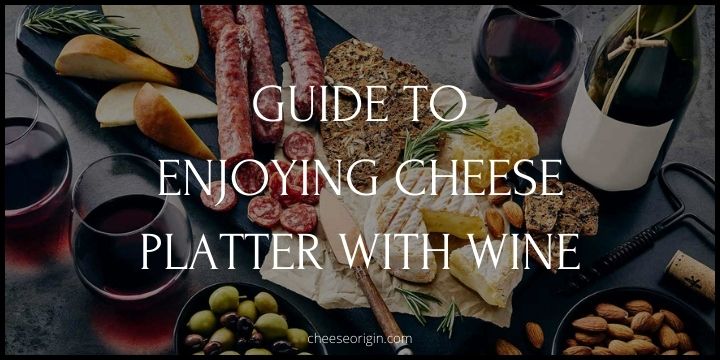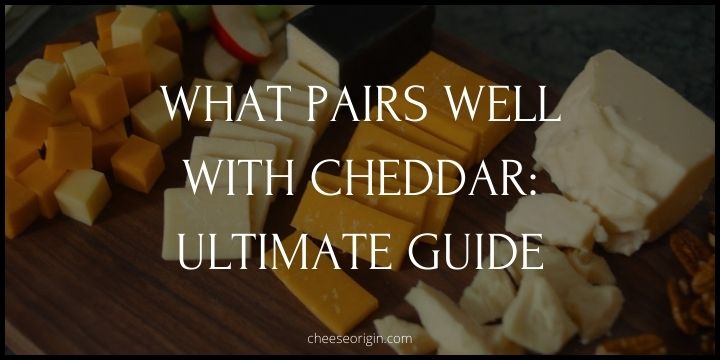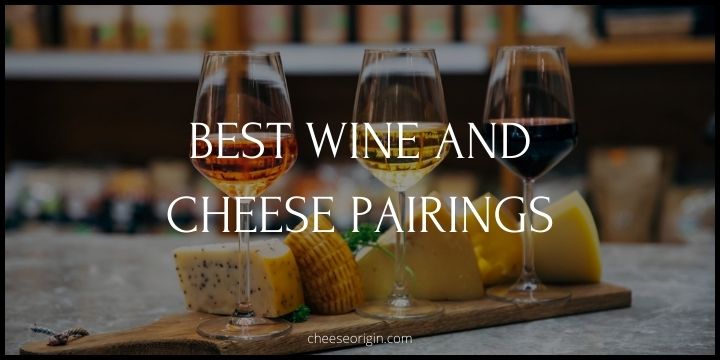A Comprehensive Guide to Enjoying Cheese Platter with Wine

Imagine this: you’re sitting outside on a beautiful evening, the sun is setting, and in front of you is an array of delicious cheeses of varying textures and flavors.
Next to it, there’s a bottle of perfectly chosen wine, waiting to be uncorked. This scene isn’t just for gourmet enthusiasts or connoisseurs – it’s an experience anyone can create and enjoy.
Pairing wine and cheese is one of life’s great culinary pleasures, and creating a cheese platter to enjoy with your favorite wines is an art form in itself.
The combination of wine and cheese offers an array of flavors and textures that can be incredibly delightful to your palate.
>> Also read: The Perfect Cheese Board: Top 10 Cheeses You Must Include
4 Important Tips to Enjoy Wine with Cheese Platter
This delightful culinary experience, when done correctly, can transport you to a world of complex flavors and textures that compliment and contrast in the most harmonious ways.
1. Cheese and Wine Pairings:
The key to a successful cheese and wine pairing is balance. The flavors of the cheese should not overpower the wine, and vice versa. Here are some classic pairings:
- Soft Cheeses: Brie and Camembert are excellent when paired with Chardonnay or Sparkling wines. The creaminess of the cheese is balanced by the acidity and effervescence of these wines.
- Semi-Hard Cheeses: Gouda and Cheddar work well with full-bodied reds like Cabernet Sauvignon or Merlot. The richness of these cheeses can stand up to the intensity of these wines.
- Blue Cheeses: The strong, pungent flavors of Blue Cheese or Roquefort are beautifully offset by the sweetness of dessert wines like Sauternes or Port.
- Hard Cheeses: Parmigiano-Reggiano and Manchego pair nicely with medium-bodied reds like Tempranillo or whites like Vermentino. The nutty, salty notes of these cheeses are complemented by the fruit-forward nature of these wines.
2. Serving Cheese and Wine:
- Temperature: Cheese should be served at room temperature for optimal flavor. Remove it from the refrigerator about an hour before serving. Wines, on the other hand, have different serving temperatures. White wines should be served chilled while red wines are best slightly below room temperature.
- Arrangement: Arrange the cheese on the platter from mildest to strongest. This allows the palate to adjust and appreciate each cheese’s unique flavor profile without being overwhelmed.
3. Common Mistakes and Tips:
- Overpowering Pairings: One common mistake is pairing a robust wine with a delicate cheese, or vice versa. The stronger flavor can overpower the other, leading to a mismatched pairing. To avoid this, remember to pair light with light and robust with robust.
- One Knife Rule: Don’t use the same knife for different cheeses. This can mix flavors and aromas, disrupting the individual taste of each cheese.
4. Enhancing the Platter:
- Fruits and Nuts: Fresh fruits like apples, pears, and grapes can cleanse the palate between different cheeses. Dried fruits and nuts add texture and pair well with many cheeses.
- Bread and Crackers: Offer a variety of bread and crackers. The neutral flavors provide a base that allows the cheese flavors to shine.
- Charcuterie: Cured meats can add another dimension to your platter. They pair well with cheeses and wines and offer a savory contrast to the creamy cheeses.
Also read: 11 Best Crackers that Pair Well with Cheese
How to Eat Cheese Platter with Wine the Right Way: A Step by Step Guide
- Preparation: Arrange the cheese on a platter, from the mildest to the strongest. Include a variety of textures and flavors – soft, hard, blue, and aged cheeses. Add accompaniments like fruits, nuts, olives, and different types of bread or crackers.
- Serving Temperature: Serve cheese at room temperature as it allows the cheese to express its full flavor. As for wine, serve white wines chilled and red wines slightly below room temperature.
- Eating Order: Start with the lightest cheese and move towards the stronger ones. This way, your palate won’t be overwhelmed by the strong cheeses first.
- Pairing: Pair each cheese with the wine that complements it best. Light cheeses pair well with light wines, while stronger cheeses can stand up to more robust wines. For example, Brie pairs well with Chardonnay, while Blue cheese often pairs well with a sweet wine like Port.
- Tasting: Take a sip of wine, then take a bite of the cheese. Notice how the flavors of both interact. Then take another sip of wine. The goal is to see how the taste of the wine changes after eating the cheese.
- Utensils: Use separate knives for each cheese to avoid mixing flavors.
- Moderation: Enjoy both the cheese and wine in moderation. The idea is to savor and enjoy the flavors, not to overindulge.
Do You Serve Cheese Platter with White or Red Wine?
Both red and white wines can be served with a cheese platter, and the choice often depends on the types of cheese you’re serving.
White Wines:
White wines tend to pair well with soft cheeses and stronger flavors. For example, a crisp Sauvignon Blanc might pair well with goat cheese, while a sweeter white wine like Riesling can complement the saltiness of fresh cheeses like mozzarella or feta.
Red Wines:
Red wines, on the other hand, often pair well with harder, aged cheeses. A bold Cabernet Sauvignon could be a great match for aged cheddar or gouda, while a lighter red like Pinot Noir might go well with a nutty cheese like Gruyère.
The truth is, the best pairing is one that suits your personal taste, so don’t be afraid to experiment and find what combinations you enjoy the most.
>> Also read: Best Wine and Cheese Pairings: The Ultimate Guide
Top 10 Wine that Goes Well with a Cheese Platter
| Wine | Description | Cheese Pairing |
|---|---|---|
| Cabernet Sauvignon | This tannic, black fruit-driven, and bold wine | Pairs well with aged cheeses like cheddar and gouda |
| Merlot | Another great option for hard cheeses | Ideal for hard cheeses |
| Bordeaux Blends | These wines complement cheddar, gouda, and other hard cheeses | Perfect with cheddar, gouda, and other hard cheeses |
| Sparkling Wine | A versatile choice that pairs well with almost everything | Complements triple-cream cheeses like Saint Andre or Explorateur |
| Sauvignon Blanc | This light, acidic white wine is a good match for a variety of cheeses | Pairs well with a variety of cheeses |
| Light-Bodied Unoaked Whites | These wines pair well with a wide range of cheeses | Excellent with a wide range of cheeses |
| Riesling | Pairs well with the saltiness of fresh cheeses | Matches well with cream cheese, mozzarella, ricotta, feta, and mascarpone |
| Rosé | Another good match for fresh, salty cheeses | Ideal for fresh, salty cheeses |
| Chardonnay | This wine goes well with medium-bodied and buttery cheeses | Complements medium-bodied and buttery cheeses |
| Young Chardonnay | Pairs well with a variety of cheeses | Matches well with a variety of cheeses |
Conclusion
Creating and enjoying a cheese platter with wine isn’t just about the food and drink – it’s about the experience.
It’s about slowing down, savoring each bite and sip, and appreciating the craftsmanship that goes into making each unique cheese and wine variety.
So, the next time you’re planning a quiet evening in or hosting a gathering of friends, consider creating a cheese platter and pairing it with some wonderful wines. It’s an opportunity to explore, learn, and most importantly, enjoy some of the finer things in life.
We hope this guide inspires you to delve deeper into the world of cheese and wine pairing and enhances your appreciation for these timeless culinary delights.
Here’s to many memorable cheese and wine experiences ahead. Cheers!
Also read:
- The Science of Cheesemaking: A Journey from Milk to Artisanal Delight
- What Kind of Cheese is Used on Nachos?
- What Pairs Well with Cheddar: The Ultimate Guide
- 12 Most Popular Cheeses in the World
- What Fruit Goes on a Charcuterie Board?
- Top 10 Champagne & Cheese Pairings to Try at Least Once
- Best Cheeses to Elevate Your Mac & Cheese: An Ultimate Guide





